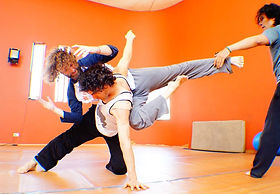


RALF JAROSCHINSKI
Born in Southern Germany and raised in Rio de Janeiro, Brazil, Ralf Jaroschinski graduated as a classical and modern dancer from the University of Music, Theater and Media in Hannover, Germany, and then studied several contemporary dance and composition techniques in New York, USA, on a stipend from the German Academic Exchange Service. He discovered contact improvisation for himself in 1994. From 1998 until 2002, he directed the dance company of the City Theater of Hildesheim, Germany, and included contact improvisation as part of the dancers' training and the creation of his works. He also got commissioned to create choreographies for several European, Asian and American municipal and national ballet companies and dance universities – so far, he has created some 100 dance pieces and improvisation scores.
Facilitating contact improvisation classes and workshops more regularly since 2004, Ralf has taught at numerous festivals, universities, dance schools and studios all over the world. He has trained the dancers of companies such as the Brazilian Curitiba Guaíra Ballet, the Australian “Canberra Dance Theatre”, “Frontier Danceland” in Singapore, the "Bangkok City Ballet" in Thailand, the German “Ballett des Theaters Pforzheim”, “Tanztheater Bielefeld” and “Tanztheater Braunschweig”, the Norwegian "Carte Blanche" in Bergen, and the Swedish "GöteborgsOperans Danskompani" and "Cullbergbaletten" in Stockholm in contact improvisation.o
INTENSIVE
Contact improvisation – counterbalancing postmodernistic fragmentation.
Despite it being a postmodern approach to dancing, contact improvisation contextualizes and unites the “me” and the “other”, it establishes community, and thus counterbalances the fragmentation and deconstruction of reality which are rather typical for postmodernism. Contact improvisation provides a sensed flux of experience and furthermore reciprocally shared sensation and experience. Due to the multi-dimensionality of the dancers’ interactions, there’s a lot of space for possibility which brings forth notions of depth, coherence, belonging, originality and authenticity. Perpetrating involvement, bonding and direct (physical) communication amongst the participants, contact improvisation makes us more human, present and more fully embodied, and virtues like solidarity and generosity become natural and normal again. Even though co-presence and co-creativity are emphasized, the individual’s autonomy doesn’t get lost underway, it’s much rather reinforced through the continuous process of constantly being mirrored and met. Clearer orientation, sharpened perceptivity, and renewed empowerment are further palpable aspects of this form’s healing effects.